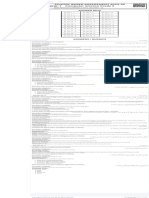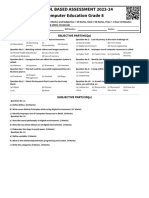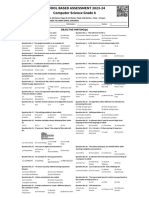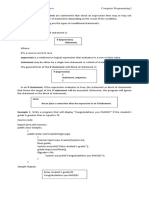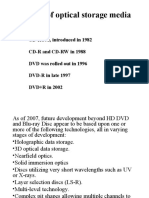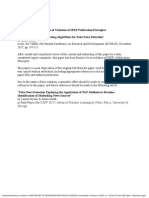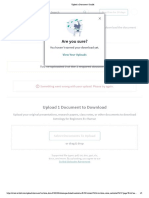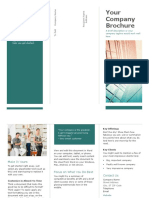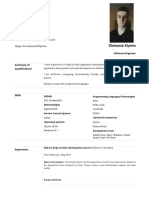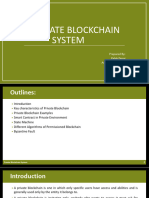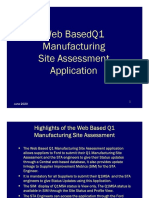SCHOOL-BASED ASSESSMENT (SBA) - 2025
END-OF-YEAR ASSESSMENT
SUBJECT: COMPUTER SCIENCE FINAL TERM
GRADE-6
[Paper A: 48 Marks, Paper B: 52 Marks, Total: 100 Marks], Time = 3 hours
School Name:
Student Name : Roll Number : Section :
OBJECTIVE PART(MCQs)
Question No.1 : An application of ICT is for: Question No.2 : CPU stands for:
(a) Traditional Schools (b) Distance Learning (a) Computer Processing Unit (b) Central Processing Unit
(c) Play Grounds (d) Travelling guides (c) Central Programming Unit (d) Computer Programming Unit
Question No.3 : The collection of raw facts and figures is known as: Question No.4 : Select the generation that included the
(a) Information (b) Data (c) Software (d) Hardware microprocessors.
(a) First (b) Second
(c) Third (d) Fourth
Question No.5 : The working window on the desktop is refered to Question No.6 : Apple computers use the operating system:
as: (a) Windows (b) Mac (c) Linux (d) Android
(a) Actual (b) Dynamic (c) Active (d) Inactive
Question No.7 : On the desktop, the taskbar is usually located at Question No.8 : Identify the link that is used to easily access a
the side: file/folder in Windows.
(a) Left (b) Right (a) Shortcut (b) Briefcase (c) Remove (d) Save
(c) Bottom (d) Top
Question No.9 : We can reduce the risk of failure of a solution by: Question No.10 : Deconstruction is also known as:
(a) Design (b) Proper planning (a) Identification (b) Definition
(c) Coding (d) Executing (c) Decomposition (d) Analysis
Question No.11 : The program is: Question No.12 : The first digital computer 'baby' was constructed
(a) Set of decisions (b) Set of instructions in:
(c) Set of tasks (d) Set of software (a) 1946 (b) 1947 (c) 1948 (d) 1949
Question No.13 : The first step for developing a program is: Question No.14 : A finite sequence of instructions to solve a
(a) Starting solution (b) Defining problem specific task is called:
(c) Making flowchart (d) Copying program (a) Solution (b) Flowchart (c) Algorithm (d) Data
Question No.15 : The character in scratch is called: Question No.16 : If the output of the program does not match with
(a) Block palette (b) Script area (c) Sprite (d) Sprite list desired result then the error will be:
(b) Semantic (d) Assignment
(a) Syntax error (c) Logical error
error error
Question No.17 : A variable used to store information is called: Question No.18 : The first step of debugging a program is:
(a) Constant (b) Value (c) Character (d) Double (a) Prove the Analysis (b) Fix and Validate
(c) Identifying the problem (d) Deleting the program
Question No.19 : Block used to get information about other sprites Question No.20 : The process of fixing errors in programming is:
is: (a) Debugging (b) Syntax (c) Decoding (d) Analyzing
(a) Sensing (b) Control
(c) Looks (d) Motion
Question No.21 : Community member is known as: Question No.22 : Piracy is:
(a) Resident (b) Citizen (c) Illegal
(a) Security (b) Privacy (d) Accuracy
(c) Immigrants (d) Stranger reproducton
Question No.23 : Responsible digital citizenship means: Question No.24 : A person who developes the skills by using the
(a) Behaving illegally (b) Behaving lawfully internet is called:
(c) Behaving rude (d) Behaving politely (d) technical
(a) citizen (b) digital citizen (c) new citizen
citizen
Question No.25 : An entrepreneur is one who: Question No.26 : Online payment network PayPal created by:
(a) works for a company (b) starts his own business (a) Numan Skinder (b) Bill Gates
(c) invests in stocks (d) works in a bank (c) Elon Musk (d) Zaheer Udeen Babar
Question No.27 : The final step of entrepreneurial process is:
(a) planning (b) harvesting (c) resourcing (d) developing
�Question No.28 : Entrepreneurial process ends on step:
(a) resourcing (b) harvesting
(c) company management (d) discovery
Question No.29 : Podio mobile application is used to: Question No.30 : Challenge faced by digital entrepreneurship is:
(a) edit Images (b) edit videos (a) maintaining a physical store (b) managing team of employees
(c) enhance business (d) play games (c) hiring labours (d) adopting a new technology
Question No.31 : The fourth step in the entrepreneurship process Question No.32 : Self plagiarism is:
is: (a) reusing your published work (b) reusing someone else's work
(a) discovery (b) resourcing (c) using others' work without
(d) illegal actions
(c) actualization (d) harvesting citation
SUBJECTIVE PART(CRQs)
Question No: 33
a ) Write the names of any five ICT devices. (5 Marks)
b ) Write a short note on booting. (5 Marks)
Question No: 34
a ) Define repetition flow in the algorithm. (2 Marks)
b ) Write an algorithm to polish a shoe. ( 4 Marks)
c ) Differentiate between specific instructions and non-specific instructions. (4 Marks)
Question No: 35
a ) Write an algorithm to find the sum and average of three numbers. (5 Marks)
b ) Explain any two benefits of debugging. (5 Marks)
Question No: 36
a ) Why do we need debugging? (2 Marks)
b ) Differentiate between e-business and traditional business. (4 Marks)
c ) List the names of four operations of computer. (4 Marks)
Question No: 37
a ) What is meant by a digital citizen? (3 Marks)
b ) Define plagiarism, and write its two types. (4 Marks)











